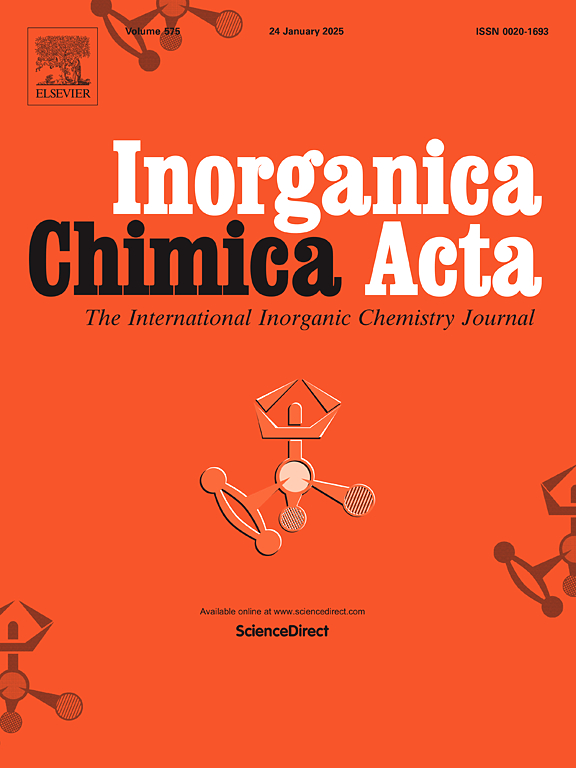Novel Ag(I) and Zn(II) complexes based on benzenesulfonamide ligand: Synthesis, characterization, and biological evaluation as multitarget antidiabetic agents
IF 2.7
3区 化学
Q2 CHEMISTRY, INORGANIC & NUCLEAR
引用次数: 0
Abstract
Three novel d10-metal complexes of the antidiabetic sulfonamide ligand (HPPS) were synthesized and characterized using elemental analysis, FTIR, NMR spectra, and single-crystal X-ray structure. The two Ag(I) complexes share the common cationic formula [Ag(HPPS)2]+, abbreviated as [1]. The structure of the studied Ag(I) complexes could be represented by the formula [1]ClO4·2H2O and [1]NO3·CH3CN. Both complexes are mononuclear, where Ag(I) is tetra-coordinated with two neutral HPPS units as bidentate ligands via the pyrazole and pyridine N-atoms. In both cases, the coordination geometry around Ag(I) is a twisted form that is intermediate between tetrahedral and square planar geometry. The Zn(II) complex [Zn4(PPS)2Cl6(H2O)2]·2EtOH, 2, is tetra-nuclear in which the Zn(II) ions are tetra- and penta-coordinated. The anionic PPS− ligand acts as a bis-bidentate ligand, bridging both independent Zn(II) sites, which are then further bridged by chloride ions to adjacent zincs. The synthesized complexes were evaluated for their in vitro α-glucosidase and α-amylase inhibitory activities and glucose uptake. The results revealed that the synthesized Ag(I) and Zn(II) complexes showed remarkably excellent antidiabetic potential. Interestingly, α-glucosidase and α-amylase inhibitory activities and glucose uptake efficacy of Ag(I) and Zn(II) complexes highly surpassed their free ligand HPPS. Ag(I) complexes([1]ClO4·2H2O and [1]NO3·CH3CN) and Zn(II) complex (2) showed excellent inhibitory potential against α-glucosidase with IC50 values of 3.68, 5.22, and 3.93 μM, respectively (2.13, 1.5, and 2 times more potent than acarbose). Ag(I) complex, [1]ClO4·2H2O and Zn(II) complex, 2 (IC50 values of 2.78 and 4.93 μM) exhibited significant α-amylase inhibitory potential, 4.8- and 2.7- fold more potent than acarbose. Ag(I) and Zn(II) complexes showed 3.38- to 3.89-fold more glucose uptake efficacy than berberine with EC50 values of 12.01, 11.15, and 10.45 μM, for [1]ClO4·2H2O, [1]NO3·CH3CN and 2, respectively. Docking studies were conducted for the synthesized silver and zinc complexes using α-glucosidase protein (PDB:2QMJ) and α-amylase (PDB:1XCW) complexed with acarbose.

求助全文
约1分钟内获得全文
求助全文
来源期刊

Inorganica Chimica Acta
化学-无机化学与核化学
CiteScore
6.00
自引率
3.60%
发文量
440
审稿时长
35 days
期刊介绍:
Inorganica Chimica Acta is an established international forum for all aspects of advanced Inorganic Chemistry. Original papers of high scientific level and interest are published in the form of Articles and Reviews.
Topics covered include:
• chemistry of the main group elements and the d- and f-block metals, including the synthesis, characterization and reactivity of coordination, organometallic, biomimetic, supramolecular coordination compounds, including associated computational studies;
• synthesis, physico-chemical properties, applications of molecule-based nano-scaled clusters and nanomaterials designed using the principles of coordination chemistry, as well as coordination polymers (CPs), metal-organic frameworks (MOFs), metal-organic polyhedra (MPOs);
• reaction mechanisms and physico-chemical investigations computational studies of metalloenzymes and their models;
• applications of inorganic compounds, metallodrugs and molecule-based materials.
Papers composed primarily of structural reports will typically not be considered for publication.
 求助内容:
求助内容: 应助结果提醒方式:
应助结果提醒方式:


